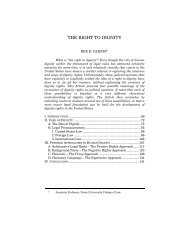A Right to Media? Lorie M. Graham - Columbia Law School
A Right to Media? Lorie M. Graham - Columbia Law School
A Right to Media? Lorie M. Graham - Columbia Law School
You also want an ePaper? Increase the reach of your titles
YUMPU automatically turns print PDFs into web optimized ePapers that Google loves.
2010] A RIGHT TO MEDIA? 465<br />
amongst indigenous peoples worldwide. 132 Such collaboration can aid<br />
in the creation of strategies for realizing rights <strong>to</strong> self-determination<br />
through the exchange of resources and insights.<br />
A number of recent U.N. studies on media and indigenous<br />
peoples illustrate in more concrete terms why media access and<br />
development are key components of ensuring indigenous peoples’<br />
self-determining rights, whether in the context of language, culture,<br />
land, discrimination, or education. While beyond the scope of this<br />
Article, these studies yield additional information on how media has<br />
been used in the past as a <strong>to</strong>ol of discrimination and exclusion<br />
against indigenous peoples, but also how media can now be used <strong>to</strong><br />
promote indigenous cultures, languages, self-representation, and<br />
other basic human rights. 133 Some of the lessons learned from these<br />
studies, however, are explored and incorporated in the next section<br />
on regional and domestic practices.<br />
IV. MEDIA PLURALISM IN REGIONAL AND DOMESTIC LAW<br />
A. <strong>Media</strong> Pluralism<br />
Despite the work of the United Nations, NGOs, and<br />
indigenous communities, stereotyped portrayals of indigenous<br />
peoples continue <strong>to</strong> be printed and broadcast. 134 A report by the<br />
Special Rapporteur on Contemporary Forms of Racism, Racial<br />
Discrimination, Xenophobia, and Related In<strong>to</strong>lerance noted that “the<br />
132. Id. at 5.<br />
133. Workshop on Indigenous <strong>Media</strong>, N.Y., N.Y., Dec. 11–14, 2000,<br />
Promoting the <strong>Right</strong>s and Cultures of Indigenous Peoples through the <strong>Media</strong><br />
passim, U.N. Doc. E/CN.4/Sub.2/AC/4/2001/3 (June 6, 2001); see also Workshop of<br />
Indigenous Journalists, Madrid, Spain, Jan. 26–28, 1998, Report of the Workshop<br />
of Indigenous Journalists, U.N. Doc. E/CN.4/Sub.2/AC.4/1998/6 (May 18, 1998)<br />
(detailing the minutes of the first meeting of indigenous journalists under the<br />
U.N. auspices); Indigenous <strong>Media</strong> Dialogue, Durban, S. Afr., The Role of the<br />
<strong>Media</strong> in Combating Discrimination Against Indigenous Peoples passim, U.N.<br />
Doc. E/CN.4/Sub.2/AC.4/2002/5 (May 16, 2002) (reporting the outcome of the<br />
second conference of participants in indigenous media calling for more training<br />
and networking).<br />
134. A 2004 study on Maori and the media found that the reporting by<br />
newspapers and television was “fairly unbalanced in their treatment of Maori<br />
people and issues.” See ECOSOC, Comm’n on Human <strong>Right</strong>s, Report of the<br />
Special Rapporteur on the Situation of Human <strong>Right</strong>s and Fundamental<br />
Freedoms of Indigenous People, Addendum, Mission <strong>to</strong> N.Z., para. 66, U.N. Doc.<br />
E/CN.4/2006/78/Add.3 (Mar. 13, 2006).















